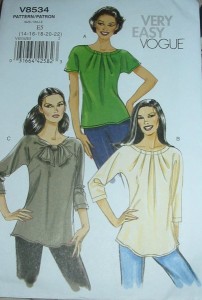Diesen Schnitte hatte ich mir mal gekauft, weil ich das mit dem Kimonoärmel mal ausprobieren wollte. Außerdem versprach „Very Easy Vogue“ ein schnelles und einfaches Projekt, das dennoch ein bißchen schicker aussieht, als eine „normale“ simple Jacke.
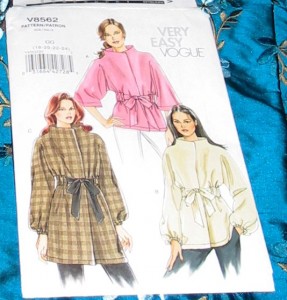 Als ich dann einen passenden Schnitt für die bestickte Seide suchte, nämlich einen der möglichst wenig Teilungsnähte hat, sprang mich der wieder an. Und angesichts meines straffen Zeitplanes erschienen mir die vier Nähte, die man dafür braucht auch sehr attraktiv.
Als ich dann einen passenden Schnitt für die bestickte Seide suchte, nämlich einen der möglichst wenig Teilungsnähte hat, sprang mich der wieder an. Und angesichts meines straffen Zeitplanes erschienen mir die vier Nähte, die man dafür braucht auch sehr attraktiv.
(English Review is on Pattern Review as usual.)
Trotzdem war ein Probeteil Pflicht, denn zum einen hätte ich die Seide nicht nachkaufen können, zum anderen habe ich seit den 80er Jahren keine Kimonoärmel mehr gehabt und war doch eher ratlos, wie ich da eine FBA durchführen sollte. Andererseits weckten die Angaben zum Umfang des Kleidungsstückes an Brust und Hüfte die Hoffnung, daß es möglicherweise ohne große Änderungen gehen könnte.
Laut Größentabelle bräuchte ich 22 an der Brust und 24 an der Hüfte, normaerweise mache ich eine 20 mit FBA und gehe dann an der Hüfte auf 22 oder 24 raus, je nach dem. Also habe ich mir den Schnitt mal mutig in Größe 20 kopiert.
Auf meine üblichen Längenänderungen oberhalb der Taille habe ich auch verzichtet, die Teile sind gerade, der Gürtel verläuft ohnehin deutlich überhalb der Taille und irgendwie dachte ich, es könnte ohne gehen.
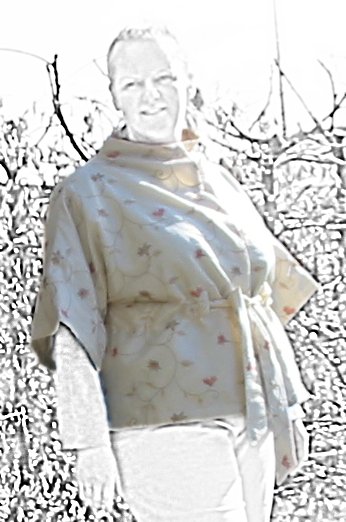 Da ich außerdem mal wieder eine neue Frühjahrsjacke brauchen konnte habe ich mir als Probeteil dann einen bestickten Polytaft aus meiner Truhe geholt. (Den hat mir Kristina mal geschenkt, weil ihn ihre Tochter doch nicht wollte oder so.)
Da ich außerdem mal wieder eine neue Frühjahrsjacke brauchen konnte habe ich mir als Probeteil dann einen bestickten Polytaft aus meiner Truhe geholt. (Den hat mir Kristina mal geschenkt, weil ihn ihre Tochter doch nicht wollte oder so.)
Ein näherer Blick auf die Anleitung zeigte mir dann, daß ich da doch einiges ändern müßte, die Verarbeitung wirkt ein wenig so, als hätte jemand nach Erstellung des Schnittes alle potentiellen Schwierigkeiten aus der Anleitung gestrichen.
So gibt es keinerlei Einlagen. Daß das nicht recht funktionieren kann, wenn man einen stehenden Kragen haben will, wie der Umschlag des Schnittmusters zeigt, war mir ziemlich klar. Nicht so gut gefällt mir auch, daß der Tunnel für den Taillengurt einfach durch steppen durch Futter und Oberstoff erzeugt wird. Das ist einfach (wobei durchaus die Gefahr besteht, daß man dabei alles verzieht, so viel zum Thema Anfängerschnitt), sieht aber nicht so schön aus. Und einfach ein großes Knopfloch um den Gürtel durchzuziehen… einfach ja, aber nicht so schön. Diese Sachen wurden also geändert. (Daß auch das Paßzeichen für die Schulter nur auf einem der Teile vorhanden war und kein Gegenstück hatte fiel für mich auch nicht ins Gewicht, aber es macht das Leben des Nähanfängers nicht einfacher.)
Ich habe mich, weil ich es auch ein wenig wärmer haben wollte, entschlossen die Vorderteile und Rückenteile mit dünnem Volumenvlies zu doppeln. Da ich nicht mehr so viel von einer Sorte hatte, haben die Vorderteile eine andere Sorte als die Rückenteile. Fällt aber nicht auf. Damit man das Volumenvlies nicht durch die Gürtellöcher sieht habe ich einen Streifen Futterstoff von Rechts festgesteppt und erst danach kam das Volumenvlies. Und die Öffnungen für das Taillenband wurden als Paspelknopflöcher gemacht. Das sieht doch besser aus.
Als Futter habe ich mein bewährtes Venezia genommen und wie in der Anleitung angegeben mit der Maschine verstürzt. Warum große Druckknöpfe von Hand annähen (und zwar so, daß man sie nicht auf der rechten Stoffseite sieht) einfacher als ein normales Knopfloch ist weiß ich nicht, aber bei „Easy“ Schnitten ist das derzeit „in“. Also kamen noch Drücker von Prym drauf.
Von der Paßform war ich dann auch recht zufrieden. Der Gürtel verläuft bei mir etwas oberhalb der Taillenlinie, bei Leuten mit normalem Oberkörper dürfte es aber schon deutlich Empirelinie sein. (Das sieht man auf dem Schnitt, auf der Zeichnung auf dem Umschlag ist das aber nicht so deutlich zu erkennen.)
Die Verarbeitung machte mich noch nicht ganz glücklich. Man sieht das Futter an dem weiten Kragen und außerdem war es trotz des Volumenvlieses doch noch recht weich und hatte die Tendenz, etwas in sich zusammenzufallen.
Also gab es für die endgültige Jacke noch ein paar Änderungen: Die Jacke ist komplett mit Wollwatteline unterlegt. (Hat einen schöneren „Fall“ als Volumenvlies) Ich habe am Saum 4cm Saumzugabe angeschnitten, habe für Kragen und vordere Kante Belege gezeichnet und an den Ärmelsäumen ebenfalls einen Saumbeleg gearbeitet. (Hierfür habe ich je einen breiten Schrägstreifen aus dem Oberstoff geschnitten.)
Die Vorderteil- und Kragenbelege wurden mit Seidenorganza gedoppelt, ebenfalls habe ich je einen Streifen Seidenorganza von Hand auf Saum und Ärmelsaum genäht.
Durch die vielen Änderungen und die Watteline mußte ich die Rehenfolge des Nähens komplett verändern, sprich die Anleitung war damit ziemlich hinfällig. Ich habe zuerst die gepaspelten Öffnungen für die Schleife in die Vorderteile genäht, dann die hintere Mittelnaht geschlossen und dann die Seitennähte. Anschließend kam ein Streifen Futterstoff auf die linke Seite um den Tunnel für den Gürtel zu bilden. Auch die Saumverstärkung aus Organza kam auf die Säume.
An der Watteline wird ebenfalls die hintere Mittelnaht geschlossen (von Hand und auf Stoß), dann ebenso die Seitennähte in der Watteline. Danach konnte ich die Wattelinie an der vorderen Kante und der Krangenkanten feststeppen und die Schulter/Ärmelnaht schließen. Diesmal durch alle Stofflagen. Dann den zusammengenähten Beleg an vorderer Kante und Kragen verstürzen, die Säume von Hand annähen und das Futter (wieder Venezia von Rieckmann-Kurzwaren) von Hand einstaffieren. (Und der Vollständigkeit halber: Die bestickte Seide war von Sacré Coupons in Paris und der Faden natürlich AlterfilS 120 von Alterfil.)
Dann nur noch die Druckknöpfe in dem schönen Bronzeton (von Plissee Becker in Köln) so aufgenäht, daß sie durch die Watteline aber nicht den Oberstoff gehen und den Gürtel einziehen. Letzterer war das Einzige, was ich tatsächlich nach Anleitung genäht habe. (Wenn man eine schöne Schleife binden will, dann sollte man überlegen, auch den Gürtel etwas mit Einlage zu verstärken.)
 Mit den Ergebnis bin ich so sehr zufrieden.
Mit den Ergebnis bin ich so sehr zufrieden.
Die Jacke fällt elegant und ist nicht steif, bringt den Stoff gut zur Geltung und ist gleichzeitig nicht zu formell. Ich kann damit also sicher auch mal eine Jeans etwas aufpeppen.
Und obwohl ich zuerst etwas Zweifel wegen der Form hatte gefällt sie mir jetzt auch für meine Größe. Die hohe Taillenlinie kommt mir sogar entgegen, denn Emprie sitzt bei mir ja immer nur ein bißchen oberhalb der Taille.
Durch die Watteline ist sie auch angenehm warm ohne schwitzig zu sein. Die helle Probejacke habe ich auch schon einige Male getragen und trotz der dünnen Vlieseinlage ist auch diese überraschend mollig. Nur wären lange Handschuhe oder Stulpen an kalten Tagen noch praktisch… (Ein Lace-Projekt….?)
Allerdings war es wirklich viel (Hand)Arbeit, die nötig war, damit die Jacke auch so edel wurde. „Schnell“ war die Jacke nicht und wenn man sie so „easy“ näht wie in der Anleitung beschrieben, dann dürte sie nicht so schön werden. Zumindest eine Lage Vlieseline am Kragen sollte man auf alle Fälle anbringen.
Zum empfehlen ist der Schnitt für Anfänger nur eingeschränkt. Zumindest ein bißchen Vlieseline sollte man einarbeiten. Aber wenn man weniger pingelig ist als ich und einen dickeren Stoff nimmt dann kann es wohl auch eine schnelle und einfache Jacke werden.
Ob ich den Schnitt noch mal verwenden werde weiß ich nicht recht, ich habe schon zwei Varianten. Wobei… in bodenlang als Morgenmantel…? (Dann aber wieder in der „einfacheren“ Variane wie die Testjacke…)
 ..diesmal für mein Bücherregal (das nicht weniger überquillt wie meine Stoffkisten).
..diesmal für mein Bücherregal (das nicht weniger überquillt wie meine Stoffkisten).

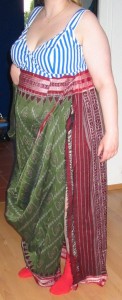
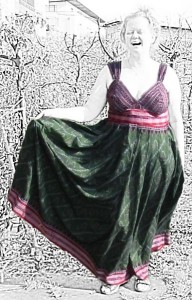





 Da ich außerdem mal wieder eine neue Frühjahrsjacke brauchen konnte habe ich mir als Probeteil dann einen bestickten Polytaft aus meiner Truhe geholt. (Den hat mir
Da ich außerdem mal wieder eine neue Frühjahrsjacke brauchen konnte habe ich mir als Probeteil dann einen bestickten Polytaft aus meiner Truhe geholt. (Den hat mir 



